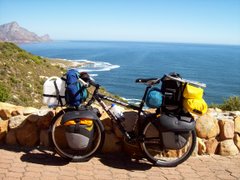











After more than a week in the city, Buenos Aires is starting to feel like home to Leana and me. But let me start at the beginning. Arriving in town after dark the previous night. we were keen to get out in the morning and experience this vibrant place. Buenos Aires is a huge city with a population of over 13 million, and the high density built-up area extends way beyond the microcentro (city centre). We walked down busy malls like Avenida Florida with craft markets and living statues, and marveled at the attractive colonial buildings in the historic city centre around Plaza De Mayo, also the famous theatre and Govt buildings. We dashed across the Av 9 De Julio (possibly the widest boulevard in the world, with its famous central obelisco), and stared at the "Pink Palace" where Evita had enchanted the crowds from the balcony (we subsequently visited her grave in the Ricoleta cemetery where people still leave flowers). In the afternoon we sat down at a pavement cafe, and that's where disaster struck - before we could place our order, Leana's bag disappeared from under the table between her feet (glasses, camera, cash, and bank cards: All gone!). So now, while we wait for the bank to send a new card, we're almost becoming citizens of Buenos Aires. (Fortunately Leana could transfer some money to my "poor" account to keep us alive in the mean time - and my sister also helped out). As I've mentioned however, one could be stuck in worse places than this. Besides all the history, there is a new "skyscraper" section towards the riverfront called Puerto Madera. We also visited the colourful La Boca district (and the Boca Juniors football stadium) where we met some famous people and entertained the crowd by dancing the tango. Besides getting around on the convenient subway system, we also took the regular suburban train out to Tigre on the Parana river delta at the outskirts of the city (and had a picnic on the riverbank). From here we're planning to take the ferry across the Rio De La Plata to Uruguay - but we're still waiting for Leana's new bank card to be delivered (and she's ordered new glasses from an optician around the corner). This whole episode is costing a lot of money - not only the hotel and replacement costs, the brazen thief actually managed to use her credit card a number of times. At least the place is colourful and interesting, with cheap Ugi's pizzas on the corner, and the ever present Parilla's (steak houses). I can also understand why people here need Siesta - they seem to stay up just about the whole night!


















































